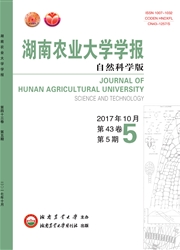

 中文摘要:
中文摘要:
选取平均体重(42.47±1.00)g的健康中华鳖,随机分为4个组,对照组饲喂基础日粮、0.05%、0.10%、0.15%添加组分别饲喂添加了相应比例复方植物提取物(植康素,主要提取自粗老茶叶、甜橙皮、桔子皮、马齿苋、野菊花、苦荞1的基础饲料,每个组3个重复,每个重复20只中华鳖,饲养30d后采样进行检测。结果表明:与对照组相比,0.05%添加组中华鳖的增重率和特定生长率显著增加(P〈0.05),0.15%添加组中华鳖的增重率和特定生长率均显著降低(P〈0.05),而0.10%添加组与对照组之间的增重率和特定生长率的差异均无统计学意义(P〉0.05);各组间中华鳖的肝脏水分、机体水分及粗蛋白含量差异均无统计学意义(P〉0.05);与对照组相比,各添加组中华鳖的肝脏脂肪含量显著降低(P〈0.05),0.05%添加组中华鳖的机体粗脂肪含量显著增加(P〈0.05),而0.10%和0.15%添加组中华鳖的机体粗脂肪含量与对照组间的差异无统计学意义(P〉0.05);各组间中华鳖的血清总蛋白、葡萄糖、谷草转氨酶、碱性磷酸酶值差异均无统计学意义(P〉0.05),但与对照组相比,各添加组中华鳖的血清尿素氮含量和乳酸脱氢酶活力均显著下降(P〈0.05),超氧化物歧化酶活力均显著增加(P〈0.05),0.10%添加组中华鳖的血清溶菌酶活力和丙二醛含量分别显著增加(P〈0.05)和显著降低(P〈0.05),而0.05%和0.15%添加组中华鳖血清溶菌酶活力和丙二醛含量与对照组间的差异均无统计学意义(P〉0.05)。综合以上结果,得出中华鳖日粮中添加0.05%此复方植物提取物可提高中华鳖的生长性能和抗氧化及免疫能力。
 英文摘要:
英文摘要:
Four experimental diets were formulated to contain 0, 0.05%, 0.10% and 0.15% composite plant extract, which were mainly extracted from coarse old tea, sweet orange, orange peel, purslane, wild chrysanthemum flower, buckwheat. Triplicate groups each with 20 Trionyx sinensis (initial body weight, 42.47±1.00 g) were fed one of the experimental diets for 30 d. The results showed that, compared with the control group, growth rate and specific growth rate significantly increased in 0.05% addition group (P〈0.05), and significantly reduced in 0.15% addition group (P〈0.05). There was no obvious change in growth rate and specific growth rate in 0.10% addition group compared to the control (P〉0.05). The difference of the contents of liver water, body water and body crude protein among groups reached no statistical significance (P〉0.05), but compared with the control group, the contents of liver fat in composite plant extract addition groups were significantly decreased (P〈0.05), and the contents of body fat in 0.05% addition groups increased significantly (P〈0.05) but showed no significant change (P〉0.05) in the other two addition groups. The content of serum total protein (TP) and glucose (Glu), the activity of apartate amino-transferase(AST) and alkaline phosphatase(AKP) among groups showed no statistically significant difference (P〉0.05), but compared with the control group, the contents of serum urea and the activities of serum lactic acid dehydrogenase (LDH) in addition groups reduced significantly (P〈0.05); the activities of serum superoxide dismutase (SOD) in addition groups significantly increased(P〈0.05); the activities of lysozyme (LZM) increased significantly (P〈0.05) and the contents of malondialdehyde (MDA) reduced significantly (P〈0.05) in 0.10% addition groups, the activities of LZM and MDA in the other two addition groups showed no statistically significant difference (P〉0.05). Based on these re
 同期刊论文项目
同期刊论文项目
 同项目期刊论文
同项目期刊论文
 期刊信息
期刊信息
